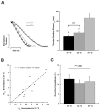Increased cross-bridge recruitment contributes to transient increase in force generation beyond maximal capacity in human myocardium
- PMID: 29141185
- PMCID: PMC5801127
- DOI: 10.1016/j.yjmcc.2017.11.007
Increased cross-bridge recruitment contributes to transient increase in force generation beyond maximal capacity in human myocardium
Abstract
Cross-bridge attachment allows force generation to occur, and rate of tension redevelopment (ktr) is a commonly used index of cross-bridge cycling rate. Tension overshoots have been observed briefly after a slack-restretch ktr maneuver in various species of animal models and humans. In this study, we set out to determine the properties of these overshoots and their possible underlying mechanism. Utilizing human cardiac trabeculae, we have found that tension overshoots are temperature-dependent and that they do not occur at resting states. In addition, we have found that myosin cross-bridge cycle is vital to these overshoots as inhibition of the cycle results in the blunting of the overshoots and the magnitude of the overshoots are dependent on the level of myofilament activation. Lastly, we show that the number of cross-bridges transiently increase during tension overshoots. These findings lead us to conclude that tension overshoots are likely due to a transient enhancement of the recruitment of myosin heads into the cross-bridge cycling, regulated by the myocardium, and with potential physiological significance in determining cardiac output.
News and noteworthy: We show that isolated human myocardium is capable of transiently increasing its maximal force generation capability by increasing cross-bridge recruitment following slack-restretch maneuver. This process can potentially have important implications and significance in cardiac contraction in vivo.
Keywords: Cardiac contraction; Cardiac regulation; Contractile kinetics; Cross-bridge cycling rate.
Copyright © 2017 Elsevier Ltd. All rights reserved.
Figures







Similar articles
-
Impact of heart rate on cross-bridge cycling kinetics in failing and nonfailing human myocardium.Am J Physiol Heart Circ Physiol. 2019 Sep 1;317(3):H640-H647. doi: 10.1152/ajpheart.00163.2019. Epub 2019 Jul 26. Am J Physiol Heart Circ Physiol. 2019. PMID: 31347914 Free PMC article.
-
Influence of Ca2+ on force redevelopment kinetics in skinned rat myocardium.Biophys J. 1996 Jun;70(6):2819-29. doi: 10.1016/S0006-3495(96)79851-X. Biophys J. 1996. PMID: 8744319 Free PMC article.
-
Impact of temperature on cross-bridge cycling kinetics in rat myocardium.J Physiol. 2007 Oct 15;584(Pt 2):591-600. doi: 10.1113/jphysiol.2007.138693. Epub 2007 Aug 23. J Physiol. 2007. PMID: 17717017 Free PMC article.
-
Characterization of cross-bridge elasticity and kinetics of cross-bridge cycling during force development in single smooth muscle cells.J Gen Physiol. 1988 Jun;91(6):761-79. doi: 10.1085/jgp.91.6.761. J Gen Physiol. 1988. PMID: 3047311 Free PMC article. Review.
-
Regulation of contraction in striated muscle.Physiol Rev. 2000 Apr;80(2):853-924. doi: 10.1152/physrev.2000.80.2.853. Physiol Rev. 2000. PMID: 10747208 Review.
Cited by
-
The Case for, and Challenges of, Human Cardiac Tissue in Advancing Phosphoprotein Research.Front Physiol. 2022 Mar 23;13:853511. doi: 10.3389/fphys.2022.853511. eCollection 2022. Front Physiol. 2022. PMID: 35399265 Free PMC article. Review.
References
-
- Varian KD, Raman S, Janssen PML. Measurement of myofilament calcium sensitivity at physiological temperature in intact cardiac trabeculae. Am J Physiol-Heart C. 2006;290(5):H2092–H7. - PubMed
-
- Milani-Nejad N, Canan BD, Elnakish MT, Davis JP, Chung JH, Fedorov VV, et al. The Frank-Starling mechanism involves deceleration of cross-bridge kinetics and is preserved in failing human right ventricular myocardium. American journal of physiology Heart and circulatory physiology. 2015;309(12):H2077–86. - PMC - PubMed
Publication types
MeSH terms
Grants and funding
LinkOut - more resources
Full Text Sources
Other Literature Sources

